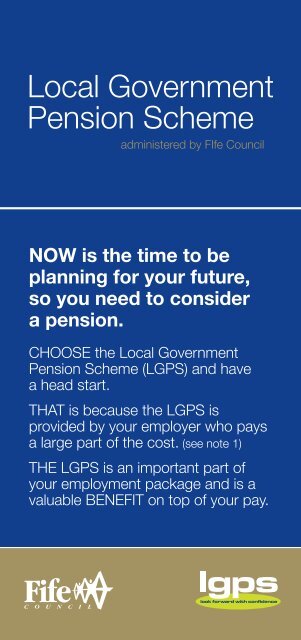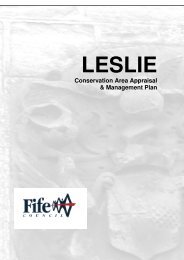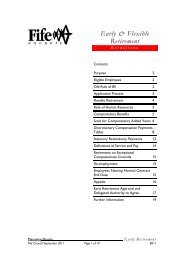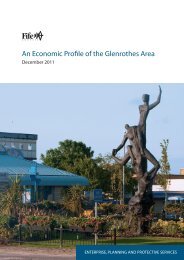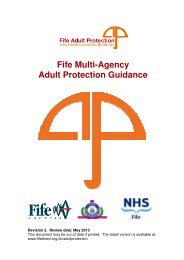Local Government Pension Scheme
Local Government Pension Scheme
Local Government Pension Scheme
You also want an ePaper? Increase the reach of your titles
YUMPU automatically turns print PDFs into web optimized ePapers that Google loves.
<strong>Local</strong> <strong>Government</strong><br />
<strong>Pension</strong> <strong>Scheme</strong><br />
administered by FIfe Council<br />
NOW is the time to be<br />
planning for your future,<br />
so you need to consider<br />
a pension.<br />
CHOOSE the <strong>Local</strong> <strong>Government</strong><br />
<strong>Pension</strong> <strong>Scheme</strong> (LGPS) and have<br />
a head start.<br />
THAT is because the LGPS is<br />
provided by your employer who pays<br />
a large part of the cost. (see note 1)<br />
THE LGPS is an important part of<br />
your employment package and is a<br />
valuable BENEFIT on top of your pay.
LET’S look at the cost and benefits of joining<br />
the LGPS that apply from 1 April 2013.<br />
The cost of being a member of the LGPS is LESS<br />
than you might think.<br />
HOW MUCH it costs depends on how much you<br />
are paid. There is a five tier contribution system,<br />
with contributions based on how much of your pay<br />
falls into each tier.<br />
If you work part-time, your contribution rate will be<br />
worked out on the whole-time pay rate for your<br />
job, although you will only pay contributions on the<br />
pay you actually earn.<br />
The table for the allocation of rates for 2013/14 is:<br />
Whole Time Pay<br />
On earnings up to and including<br />
£19,800<br />
On earnings above £19,800 and<br />
up to £24,200<br />
On earnings above £24,200 and<br />
up to £33,200<br />
On earnings above £33,200 and<br />
up to £44,200<br />
Contribution<br />
Rate (%)<br />
5.50%<br />
7.25%<br />
8.50%<br />
9.50%<br />
On earnings above £44,200 12.00%<br />
The pay ranges will be increased each April in line<br />
with the cost of living.<br />
Let’s take a look at someone who works<br />
full-time at a pay rate of £22,000.<br />
They’ll pay 5.5% on their pay up to £19,800,<br />
and 7.25% on the next £2,200. That gives an<br />
overall contribution rate of 5.7% - around £97<br />
per 4 weekly in contributions.<br />
If they were working part-time, the contribution<br />
rate would still be 5.7% - that’s because the<br />
whole-time rate for their job is still £22,000.<br />
However, the amount of their contributions<br />
would be based on their part-time earnings<br />
therefore, an employee working 18 hours per<br />
week, or 50%, would pay around £48.50 per 4<br />
weekly.
IT COSTS EVEN LESS if you pay tax and<br />
National Insurance as you get tax relief on your<br />
contributions and pay a lower rate of National<br />
Insurance.<br />
THE LGPS is one of the best ways to plan for<br />
retirement with an excellent range of benefits<br />
that both full-time and part-time employees<br />
can enjoy.<br />
THESE INCLUDE, after 2 years in the scheme:<br />
• A tiered ill health retirement package if you have<br />
to leave work at any age due to permanent ill<br />
health. This gives graded levels of benefit based<br />
on how likely you are to be capable of gainful<br />
employment after you leave, with a higher level<br />
of benefit for those more seriously ill.<br />
• Early payment of benefits if you are made<br />
redundant or retired on business efficiency<br />
grounds and you are aged 55 or over.<br />
• The right to voluntarily retire from age 60 years,<br />
even though the <strong>Scheme</strong>’s normal pension age<br />
is 65. You can even retire from as early as age<br />
55 years, provided your employer agrees.<br />
• Flexible retirement from age 55 years if you<br />
reduce your hours, or move to a less senior<br />
position and, if you are under age 60 and your<br />
employer agrees, you can draw some or all of<br />
your benefits – helping you ease into retirement.<br />
• If you choose to voluntarily retire, or take flexible<br />
retirement before age 65, your benefits would<br />
normally be reduced to account for them being<br />
paid for longer.<br />
• You can even stay in the LGPS if you carry on<br />
working beyond age 65, although you have to<br />
draw your benefits by age 75. Benefits drawn<br />
after age 65 attract additional increases.<br />
There is also:<br />
• Life cover from the moment you join, with a<br />
lump sum of 3 years pay being paid if you die in<br />
service.<br />
• Cover for your family, with a pension for your<br />
husband, wife, registered civil partner (see note<br />
2) or nominated co-habiting partner (see note<br />
3) and for eligible children if you die in service or<br />
die after leaving with a pension entitlement.
WHEN YOU RETIRE<br />
you can look forward to:<br />
A pension for life that increases with the cost of<br />
living and you can exchange part of your annual<br />
pension for a one off tax-free cash payment.<br />
Even More<br />
It’s a final salary scheme, which means your<br />
benefits are normally based on your final year’s<br />
pensionable pay and the number of years you<br />
have been a member of the scheme.<br />
How are benefits worked out?<br />
For each year in the scheme you receive a pension<br />
of 1/60th of your final year’s pensionable pay.<br />
And, if you want to take a tax free lump sum, for<br />
each £1 of pension you give up you get £12 of<br />
lump sum. You can take up to 25% of the capital<br />
value of your pension benefits as a lump sum.<br />
Here’s how it’s worked out: Full-timers<br />
Mrs A is 65 and has 20 years full time<br />
membership in the scheme.<br />
Her final year’s pensionable pay is £15,000<br />
Her annual pension would be:<br />
20 years x 1/60 x £15,000 = £5,000<br />
If she decided to give up £1,000 pension for a<br />
cash lump sum, then:<br />
Her reduced annual pension is:<br />
£5,000 less £1,000 = £4,000<br />
To give a tax-free lump sum of:<br />
£1,000 x 12 = £12,000
Here’s how it’s worked out: Part-timers<br />
Your membership is reduced to reflect parttime<br />
working but full-time pay is used in the<br />
calculation.<br />
Mr B is 65 and also has contributed to the<br />
scheme for 20 years. However he has always<br />
worked 50% in his job with the same rate of pay<br />
as Mrs A.<br />
His annual pension would be:<br />
20 years x 50% x 1/60 x £15,000 = £2,500<br />
Mr B’s membership is adjusted to reflect the<br />
part-time hours he works (20 years x 50%).<br />
If he decided to give up £500 pension for a cash<br />
lump sum, then:<br />
His reduced annual pension is:<br />
£2,500 less £500 = £2,000<br />
To give a tax free lump sum of:<br />
£500 x 12 = £6,000<br />
If Mr B’s hours had changed during his<br />
membership of the scheme, his benefits would<br />
be calculated to reflect the change.<br />
You can look forward with confidence<br />
with the LGPS, because:<br />
• contributions you pay today will provide you with<br />
retirement benefits based on your pensionable<br />
pay in the year you leave. This means the<br />
pension you build up during employment keeps<br />
pace with rises in your pay.<br />
• after retirement, your pension increases with the<br />
cost of living.<br />
• your benefits are secure. They are set out in law.<br />
and you can:<br />
• pay more to increase your benefits.<br />
• ask to transfer previous pension rights into the<br />
scheme.
Something to think about...<br />
When it’s time for you to retire will the State<br />
retirement pension alone offer the security you will<br />
need, or want?<br />
You can find out about your state pension and<br />
how to request a state pension forecast from, The<br />
<strong>Pension</strong> Service at www.thepensionservice.gov.uk<br />
You can also request a state pension forecast by<br />
telephoning the State <strong>Pension</strong> Forecasting Team<br />
on 0845 300 168.<br />
Who can join?<br />
The LGPS covers local government and other<br />
organisations that have chosen to participate in it.<br />
To be able to join the LGPS you need to be under<br />
age 75 and, if you are employed by an admission<br />
body, you can only join if your employer nominates<br />
you for membership of the scheme.<br />
If you start a job in which you are eligible for<br />
membership of the LGPS, you will automatically<br />
be brought into the scheme, unless your contract<br />
of employment is for less than 3 months in which<br />
case you can opt to join by completing the<br />
membership form.<br />
If you are brought into the scheme you have the<br />
right to opt out. However, you cannot complete<br />
an ‘Opt out Form’ until you have started your<br />
employment.
Instructions for joining<br />
Fife Council Employees<br />
You will be issued with pension pack which will<br />
contain a ‘Membership Form’. If you wish to<br />
join the pension scheme you must complete and<br />
return this form. This ensures an accurate pension<br />
record is set-up for you. You also have the right to<br />
opt out of the pension scheme. See details below<br />
All other employees<br />
Your employer will give you the option to join the<br />
pension scheme. If you decide to join you must<br />
complete a ‘Membership Form’.<br />
Any employee who wishes to opt out of the LGPS<br />
can access an ‘Opt out Form’ under ‘Forms &<br />
Publications’ in our mini-site. This can be found on<br />
FISH or at www.fifedirect.org.uk/LGPS.<br />
Check your payslip to make sure you if you<br />
opted in, that pension scheme deductions are<br />
being taken off, or if you opted-out, to make<br />
sure no deductions are being taken.<br />
Want to know more?<br />
This leaflet gives a brief outline of the LGPS as it<br />
applies from 1st April 2009. If you want to know<br />
more, or if you have membership in the scheme<br />
before 1st April 2009 and would like to know how<br />
benefits built up before then are worked out, you<br />
can get information from:<br />
• www.fifedirect.org.uk/lgps<br />
• www.lgps.org.uk<br />
And you can get a full <strong>Scheme</strong> Guide from the<br />
Payroll/<strong>Pension</strong> Team. Contact details are on the<br />
back page of this leaflet.<br />
As previously stated, this leaflet is a brief guide to<br />
the LGPS and does not cover every circumstance.<br />
In the event of any dispute over your pension<br />
benefits, the appropriate legislation will prevail. The<br />
leaflet does not confer any contractual or statutory<br />
rights and is provided for information purposes<br />
only.
Notes<br />
1. Increases or decreases in the cost of providing<br />
the scheme may, in the future, need to be<br />
shared between members and employers,<br />
in accordance with guidance from Scottish<br />
Ministers.<br />
2. A civil partnership is a relationship between two<br />
people of the same sex (“civil partners”) which<br />
is formed when they register as civil partners of<br />
each other.<br />
3. In order to nominate a co-habiting partner, your<br />
relationship must meet certain criteria.<br />
Fife Council <strong>Pension</strong> Team<br />
Contact Details.<br />
For more information contact the<br />
Payroll / <strong>Pension</strong> Team on 01592 583278, or<br />
pensions.section@fife.gov.uk<br />
Or write to<br />
Payroll / <strong>Pension</strong> Team<br />
<strong>Pension</strong> Section<br />
Fife Council<br />
North Street<br />
Glenrothes<br />
Fife<br />
KY7 5LT<br />
Published May 2013


